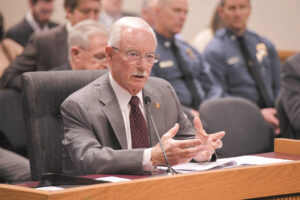9:30
News Story
‘We can’t keep putting our lives on the line’: KC bus drivers detail safety risks they face
Sherrita Jackson was a bus driver for 21 years before she got fed up with abuse from passengers and switched careers in 2021.
At the time, a year into the COVID-19 pandemic, passengers were required to wear masks. A passenger not wearing a mask boarded Jackson’s bus and refused to comply with the mandate.
“He threw a shoe and hit me in the face,” Jackson said. That was the fourth time in her career that a passenger assaulted her.
Some local bus drivers say that sort of violence happens too often, and it’s why many of them quit. That’s true even though the Kansas City Area Transportation Authority hired 55 drivers last fall, exceeding its end-of-year goal, and 50 of those drivers still worked for the agency as of Monday.
KCATA is not short-staffed right now, Chief Operations Officer Chuck Ferguson said. The agency employs 284 full-time bus operators and 22 part-time operators.
But unless ongoing safety concerns are addressed, some drivers say, KCATA will struggle to recruit and retain workers.
Across the country, violent passengers are pushing many bus drivers to step away from the wheel, recent data show. Ninety-six percent of transit agencies surveyed last year reported driver shortages to the American Public Transportation Association. Assaults against bus operators quadrupled from 2009 to 2020, according to the Federal Transit Administration.
So far this year in Kansas City, there have been eight recorded assaults against bus operators, four of them physical, said Cindy Baker, vice president of communications for KCATA.
There typically were roughly 30 assaults against drivers each year until about five years ago, when KCATA installed barriers on the buses to separate drivers and passengers, she said. Passengers can reach around the barriers, but the number of recorded physical assaults against drivers significantly declined — falling to six incidents in 2018, according to KCATA data. There have been less than a dozen recorded incidents each year since then.
But Jackson said the number of recorded assaults does not accurately represent the violent encounters drivers deal with each day. She said KCATA once told her the day after a scheduled court hearing for an assault case that she had been subpoenaed.
“If you don’t go, those charges get dropped and then they have no case against the person who harmed you,” Jackson said. “And the company can say there was no assault because no one was prosecuted.”
KCATA only receives subpoenas when the driver’s personal information isn’t documented, Baker said, but she acknowledged that the agency has become more proactive when communicating about court proceedings.
“That’s a complaint that we have heard in the past from operators. And truly, we were not as diligent, say, five years ago,” she said.
Baker said KCATA is arranging meetings with the drivers union to discuss their safety concerns.
What is being done to ensure bus drivers’ safety?
KCATA contracts with Titan Protection Security to provide 20 armed officers to its bus operations. The company has another six guards completing training with the Kansas City Police Department.
The guards patrol the bus service areas to respond to driver emergencies.
Multiple guards are positioned throughout the routes during each shift, at bus stops, patrolling routes or riding the buses. Up to nine officers are on duty between 10 a.m. and 4 p.m. — the peak window for passenger disturbances, Ferguson said.
Still, drivers say the guards aren’t preventing violent incidents with passengers or even between passengers. Jackson said a driver told her a few weeks ago about a shooting that happened on their bus.
“We can’t continue to put our lives on the line,” Jackson said. “It’s like we’re punished for doing our job by the general public.”
Titan officers can only detain people until police arrive. Two officers from the Kansas City Police Department are assigned to KCATA’s security team, but Ferguson said they are often overwhelmed. The agency is in talks with the police department to recruit two more officers.
Meanwhile, when there is an issue, drivers can press an emergency button on the bus to alert security. Buses are equipped with interior and exterior cameras, although the recordings are not monitored live “at this point,” Ferguson said.
Addressing the reasons why drivers quit
Aside from the security concerns, KCATA has made improvements aimed at improving drivers’ job satisfaction. In October, KCATA bargained with the drivers union for new contract terms, which included raising starting wages from $17 an hour to $23 an hour and allowing prior commercial driver’s license training experience in place of a GED diploma.
Increasing compensation was an important element of contract negotiations for local drivers. Pay is a significant reason why bus drivers quit since the coronavirus pandemic, according to the American Public Transportation Association’s 2022 Transit Workforce Shortage Study.
But the new wages alone aren’t enough, said Nic Miller, president of Amalgamated Transit Union Local 1287.
“The financial piece is fine,” he said. “The issue that needs to be addressed now is ridership.”
This story was originally published by The Kansas City Beacon, an online news outlet focused on local, in-depth journalism in the public interest.
Our stories may be republished online or in print under Creative Commons license CC BY-NC-ND 4.0. We ask that you edit only for style or to shorten, provide proper attribution and link to our website. AP and Getty images may not be republished. Please see our republishing guidelines for use of any other photos and graphics.





